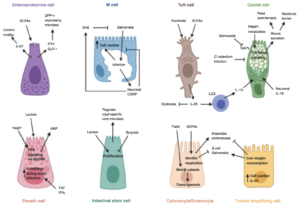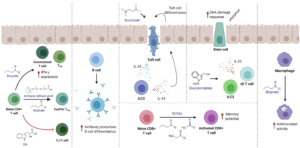High-Throughput Screen Identifies Host and Microbiota Regulators of Intestinal Barrier Function
Background & aims: The intestinal barrier protects intestinal cells from microbes and antigens in the lumen-breaches can alter the composition of the intestinal microbiota, the enteric immune system, and metabolism. We performed a screen to identify molecules that disrupt and support the intestinal epithelial barrier and tested their effects in mice.
Methods: We performed an imaging-based, quantitative, high-throughput screen (using CaCo-2 and T84 cells incubated with lipopolysaccharide; tumor necrosis factor; histamine; receptor antagonists; and libraries of secreted proteins, microbial metabolites, and drugs) to identify molecules that altered epithelial tight junction (TJ) and focal adhesion morphology. We then tested the effects of TJ stabilizers on these changes. Molecules we found to disrupt or stabilize TJs were administered mice with dextran sodium sulfate-induced colitis or Citrobacter rodentium-induced intestinal inflammation. Colon tissues were collected and analyzed by histology, fluorescence microscopy, and RNA sequencing.
Results: The screen identified numerous compounds that disrupted or stabilized (after disruption) TJs and monolayers of epithelial cells. We associated distinct morphologic alterations with changes in barrier function, and identified a variety of cytokines, metabolites, and drugs (including inhibitors of actomyosin contractility) that prevent disruption of TJs and restore TJ integrity. One of these disruptors (putrescine) disrupted TJ integrity in ex vivo mouse colon tissues; administration to mice exacerbated colon inflammation, increased gut permeability, reduced colon transepithelial electrical resistance, increased pattern recognition receptor ligands in mesenteric lymph nodes, and decreased colon length and survival times. Putrescine also increased intestine levels and fecal shedding of viable C rodentium, increased bacterial attachment to the colonic epithelium, and increased levels of inflammatory cytokines in colon tissues. Colonic epithelial cells from mice given putrescine increased expression of genes that regulate metal binding, oxidative stress, and cytoskeletal organization and contractility. Co-administration of taurine with putrescine blocked disruption of TJs and the exacerbated inflammation.
Conclusions: We identified molecules that disrupt and stabilize intestinal epithelial TJs and barrier function and affect development of colon inflammation in mice. These agents might be developed for treatment of barrier intestinal impairment-associated and inflammatory disorders in patients, or avoided to prevent inflammation.
Visit full article page:
https://www.sciencedirect.com/science/article/abs/pii/S0016508520349210

